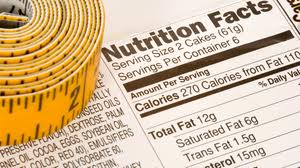How To Stop Counting Calories - For Good!
I hope after last week’s post you’re recognizing the limitations in counting calories. But, you can’t just DO NOTHING. So, let’s talk about what you should do instead.
Just Eat Real Food
You want to know the real secret to not counting calories from food labels? Eat food WITHOUT labels. Fruits, vegetables, lean proteins, grains (think quinoa, steel cut oatmeal, rice), and healthy fats all fit the bill. Ditch packaged and processed foods - anything with more than 5 ingredients in the label.
If most of your food is packaged, start by replacing just one item a day with something natural. Ultimately, aim for 80%-90% whole foods in your diet.
Restructure Your Plate
I’m going to go out on a limb here and say that growing up you were probably familiar with the food pyramid as a guide to what you should eat. No wonder everyone started counting calories - the pyramid did a poor job of helping people identify real food portions!
Did you know that in 2011 a new food icon was introduced in the US? The MyPlate icon was rolled out in early summer of 2011 (shown below) and has since been improved upon by Harvard School of Public Health with the replacement of milk with a glass of water, incorporation of more vegetables, and the inclusion of a healthy fat. The new plate icons make food portioning much more accessible by showing you what your plate should look like at every meal.
When planning a meal, use the Harvard School of Public Health graphic as a guideline. I personally advocate making half of your plate vegetables, adding a lean protein roughly the size and thickness of your palm (approximately 3 ounces for women and 4 ounces for men), incorporating a healthy grain for no more than a quarter of your plate, and adding in a small amount of healthy fat such as olive oil, nuts, or avocado.
Be Mindful
In this day and age, we’re all guilty of it. Whether it’s eating in front of the computer or TV or incessantly checking your phone at meal time, you’re probably distracted when you eat.
Research suggests that people eat less at any given meal when they are focused on the meal in front of them (and conversely eat MORE when they are distracted). Disconnect from electronic devices, focus on chewing each bite fully, and engage your senses to notice the smell, taste, texture and color of your food.
Reflect On Your Previous Meals
A report published by the American Journal of Clinical Nutrition suggests that we draw on memories about the satisfaction of our most recent meal when we make decisions about what and how much to eat next.
Simply taking a moment before each meal to acknowledge what was eaten that day is enough. Alternatively, consider photo documenting each meal with a quick cell phone snap shot and glancing through your photo roll before you sit down to eat.
As you can see here, healthy eating is as much about eating real, whole foods as it is being conscious of what you’re putting into your body. Consistently focusing on both these practices will ultimately lead to health gains and weight loss without ever having to counting calories again.
In the comments, tell me what practice above you struggle with and what step you’re going to take towards correcting it. I’ll go first – I am always distracted when I eat. I need to stop that. I know better!











